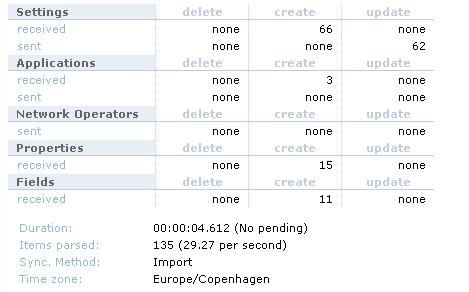
Messages in the Synchronizing category show statistics about the client's synchronization with the DME server. Usually a log entry of the category Collaboration, pertaining to the same device, will precede this entry. The Collaboration log entry shows the interaction between collaboration system and the connector; this entry shows the interaction between the DME server and the client. The information is shown as a table, which might look like this:

For each type of synchronization data (function), a column tells how many items were deleted, created, or updated. Depending on the type of item, the data can be received or sent. Received means that the data was received from the client by the server; sent means that the data was sent from the server to the client.
Function |
This is the type of synchronization (function) which was performed with the collaboration system. This could be E-mail, Calendar, Addressbook, or E-mail folder sync. |
Entries |
How many items of the specified type were synchronized from the client (received) or from the server (sent) as a result of the current connection. |
Sync. method |
How were the items synchronized - as a result of a push, scheduled sync. or a manual sync. If the sync. method is followed by flush, it means that the data was imported by the client (deleted on the client first, then synchronized). One way means that the current synchronization was part of a batch, and that nothing was actually sent to the device. The client controls when the server should send the entire batch. |
Time zone |
The time zone of the client. This can be useful in case questions arise regarding differences in the time of meetings between the client and the collaboration system. |
The times and data amounts in the Synchronizing category are part of the total for the current device specified in the Network category.
Furthermore, statistics about the client's exchange of system information with the DME server are logged as an entry in the Synchronizing category. This information is also shown as a table, which might look like this:

System information, for instance client settings, from the client are compared with those set on the server, and the settings are synchronized. Mandatory settings from the server are enforced on the client, and the server representation of the client is updated to reflect the personalized, non-mandatory settings from the client. The following table explains the various items in the graphic above.
For each type of system information data, a column tells how many items were deleted, created, or updated. Depending on the type of system information, the data can be received or sent. Received means that the data was received from the client by the server; sent means that the data was sent from the server to the client.
Settings |
Settings are pieces of information set in the Settings tabs in the client, or in the default, group, or individual device settings pages on the server. For instance, in the graphic above, 66 settings were created on the server to reflect settings on the client. In return, the server updated 62 of these settings and pushed them back to the client. |
Applications |
This type of data indicates the number of blocked applications and network connections. |
Network operators |
This type of data indicates the number of preferred network operators sent to the client. |
Properties |
This type of data indicates information about device properties received from the device and registered in the Information page section for the device in question. |
Fields |
This type of data indicates information about which contact and calendar fields are supported by the device in question. |
Duration |
This row shows the total duration of the client's interaction with the DME server during this session. The parentheses following the duration in seconds indicate if there are any items pending processing, in other words if the system information exchange is complete. If not, you need to refresh the Log page to view the finished results. |
Items parsed |
This row shows how many items (settings, applications, etc.) were processed in total, and how many were processed per second. |
Sync. method |
This row shows if the interaction with the server was caused by a synchronization, a push, or an import action. |
Time zone |
This row shows the time zone of the client. |